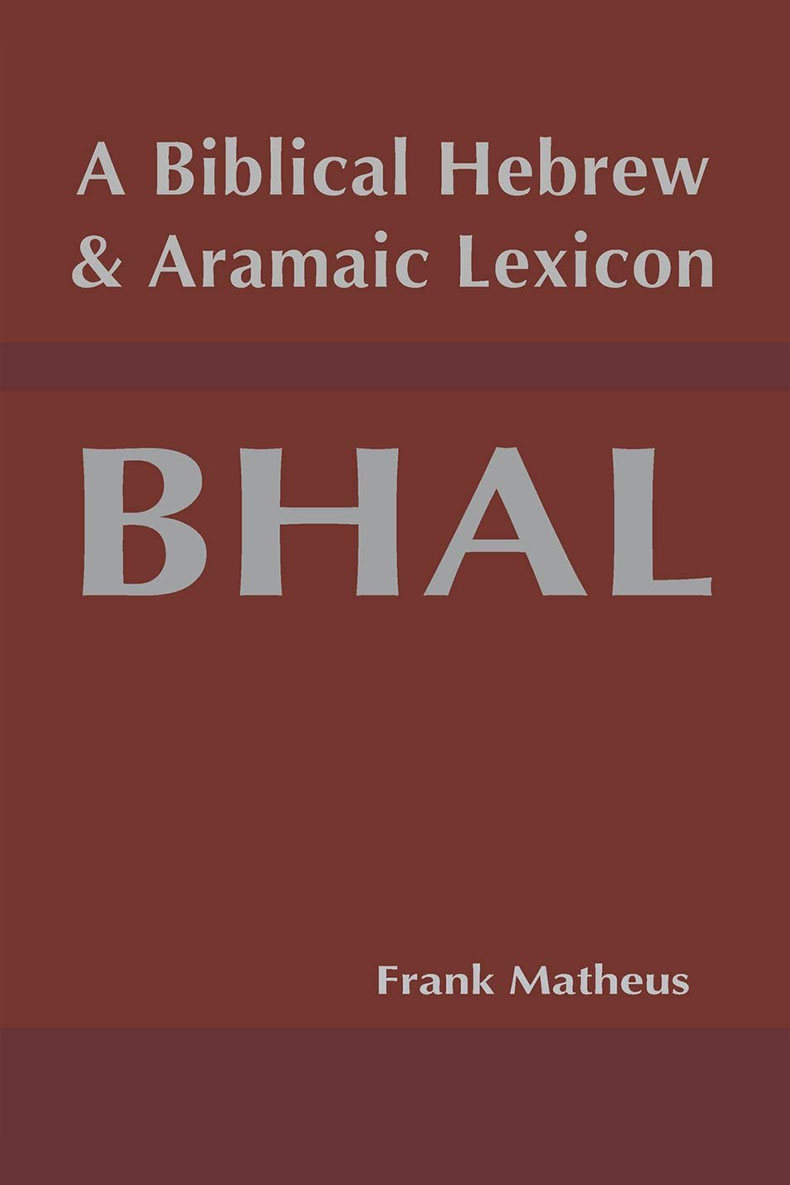A Biblical Hebrew and Aramaic Lexicon, by Frank Matheus. Wilmore, KY: GlossaHouse, 2020. x + 388 pp. $29.99.
There is a dearth of up-to-date, inexpensive, and user-friendly lexicons for biblical Aramaic. While BDB remains quite useful in many ways, it was first published in 1907. This, therefore, predates not only the modern linguistic period but also the discoveries of several important documents that are highly pertinent to the study of Aramaic, such as, for instance, the Dead Sea Scrolls from Qumran and other sites in the Judean desert. In contrast, however, HALOT is much more recent (and, in certain respects, also more comprehensive). The fifth (and final) volume of the Hebrew Aramaic Lexicon of the Old Testament set (Aramaic) was first published in 2000 by Brill. The entire work was re-issued in 2001 (also by Brill) as an unabridged two-volume work. Though lexicographers agree that HALOT is irreplaceable for all serious study, its exorbitant cost often places it out of reach for most students and its overarching format (this includes the sheer wealth of information available!) is somewhat counter-intuitive for many uninitiated users. Many of the same caveats relevant to HALOT also apply to Gzella’s TDOT (Eerdmans, 2018).
Enter A Biblical Hebrew and Aramaic Lexicon (BHAL), a comprehensive dictionary based upon Frank Matheus’s PONS Kompaktwörterbuch Althebräisch-Deutsch. BHAL utilizes modern lexical approaches, offers efficient access to the most pertinent information/data in an uncomplicated but comprehensive way, is exceptionally cost-effective, and is extremely clear in its presentation, thus allowing students to have quick access to all of the key details at a glance.
Said otherwise, BHAL offers numerous forms that help the user to find the word they are looking for quickly in its specific grammatical format; alongside this, with nearly 10,000 entries in total (see ix), BHAL covers the entire biblical vocabulary, including the Aramaic portions. It is, however, solely the Aramaic component of this lexicon that will be the focus of this review.
With respect to the fundamentals, the verbs are cited as roots without vowels and their forms are listed in the usual order from the suffix conjugation (also known as the so-called “perfect”) and the prefix conjugation (also known as the so-called “imperfect”) to the participle. The nouns are arranged (as normal) from status absolutus in the singular (citation form) to status constructus in the plural with the grammatical assignments being represented by a number, the resolution of which can be found in the footer on each page (more on this later). As noted by the author, this not only saves space but also helps to keep the lexicon “compact and well structured” (ix). All ketib/qere variants are listed in full and are appropriately marked. Matheus further notes, “The listed verbal forms follow the usual sequence from the third to the first person, from the masculine to the feminine, from the singular to the plural” (ix).
By way of comparison, while the Aramaic portion of William L. Holladay’s A Concise Hebrew and Aramaic Lexicon of the Old Testament (Eerdmans, 1988) is twenty-nine pages, BHAL is a mere twenty-five pages. One should also note that BHAL has substantially larger “headings” for each main entry (aleph, bet, etc.) and contains far more white space than Holladay. The total content, therefore, is substantially less per entry in BHAL than in Holladay. In addition to this, another irritant is the egregious fact that BHAL does not effectively leverage bold face type for the actual definition of each word (unlike Holladay). This makes searching through the lexicon itself a somewhat cumbersome and unnecessarily dense task at times. One does note, though, that all (undisputed) incidents are recorded in BHAL via the ⁰ (open dot) sign.
The definitions themselves are, as a whole, quite clear (though somewhat lackluster). Disappointingly, however, unlike Holladay, who uses the full terms for each of the stems (i.e., Peal, Hitpeel, Hafel, etc.), BHAL only uses abbreviations. In addition, unlike Holladay, Hebrew cognates for any given word are not included in the definition. This means that students looking to learn biblical Aramaic via the comparative method are at a (severe) disadvantage using BHAL.
In sum, while Frank Matheus’s A Biblical Hebrew & Aramaic Lexicon is an up-to-date tool that could, perhaps, supplement (at least in certain ways) Holladay’s trusted work, one would be hard-pressed to persuade me that it substantially improves on (let alone supplants) that text. In fact, I would argue that if given the choice, one would be foolish not to opt for Holladay.
That said, however, the most up-to-date, cost-effective, and user-friendly (stand-alone volume) for biblical Aramaic lexicography remains Ernst Vogt’s A Lexicon of Biblical Aramaic: Clarified by Ancient Documents (Gregorian and Biblical Press, 2011). To be clear, Fitzmyer’s work (unlike BHAL) leverages a good majority of the texts found in the Judean desert (including some of the most recent work on certain fragmentary texts, such as the Genesis Apocryphon of Qumran Cave 1). In addition to this, Fitzmyer’s work not only employs a much more conservative use of white space than BHAL but also judiciously leverages bold face type for all word definitions, contains clear and effective mark(s) for hapax legomenon (unlike BHAL) while also retaining Holladay’s dagger for all undisputed incidents, and, best of all, contains snippet citations of the context for each passage under discussion.
To conclude, whatever strengths are contained within Frank Matheus’s A Biblical Hebrew & Aramaic Lexicon they cannot make up for its not insignificant deficiencies in terms of user-friendliness, comprehensiveness, and so forth. In brief, I cannot in good conscience recommend this volume.
Dustin G. Burlet
Millar College of the Bible, Winnipeg, MB, Canada

